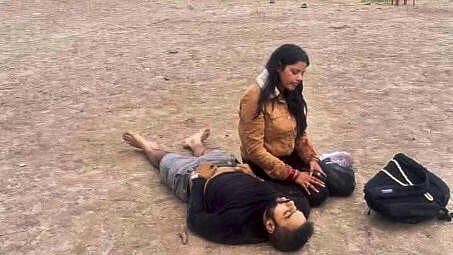
A woman sits next to a man lying on the ground after terrorists attacked a group of tourists at Pahalgam, in Anantnag district, Jammu & Kashmir
Credit: PTI Photo
Srinagar: Tuesday’s deadly terror attack on tourists in Pahalgam, a popular hill station in the Anantnag district of southern Kashmir, has shattered a longstanding pattern in the region’s decades-long conflict.
This rare and direct assault on non-pilgrim tourists marks one of the few incidents in the past 35 years where vacationers, rather than security forces or religious pilgrims, were specifically targeted.
The targeted attack, one of the deadliest in Kashmir in recent years, unfolded in Baisaran Valley, a popular tourist destination near Pahalgam in which 26 civilians, mostly tourists, were killed.
The aftermath was immediate and jarring. Tourist spots across the valley emptied out as visitors fled in panic, leaving behind deserted streets and shuttered businesses. It was as if the Valley’s tourism sector—already fragile—had been struck at its very core.
Historically, while the Kashmir Valley has seen numerous attacks on Amarnath pilgrims since 2000—with dozens of yatris killed—attacks directly targeting general tourists have remained extremely rare. Even at the peak of militancy in the 1990s and early 2000s, most militant operations focused on security forces, political figures, or symbolic infrastructure.
The last major incident involving tourists in Pahalgam dates back to 1995, when the now-defunct Al-Faran group kidnapped six foreign nationals. One was murdered, another escaped, and the fate of the remaining four remains unknown.
That episode, however tragic, was an outlier. Since then, civilian casualties among tourists have typically occurred as collateral damage in larger militant attacks or during unrest.
“This marks a disturbing shift,” said Iqbal Tramboo, a prominent hotelier in Srinagar. “Directly targeting tourists is an attempt to cripple Kashmir’s already vulnerable tourism industry and inject fear beyond the usual security concerns.”
Tourism plays a vital role in Kashmir’s economy. At the time of the attack, the valley was witnessing a surge in tourist arrivals. Hotels, houseboats, and homestays were fully booked—a rare and hopeful sign of recovery.
In response to the attack and the subsequent exodus of tourists, ruling National Conference president Farooq Abdullah made a public appeal, urging visitors not to cancel their travel plans.
“By not coming to Jammu and Kashmir, you are letting Pakistan win,” he said. “I urge you to come in even larger numbers to show them that we will not be deterred. This is our land, and we will come here in herds. Don’t be afraid—we must fight back.”
Sajjad Lone, a former separatist and current MLA from Handwara, echoed this sentiment. “Tourism is the economic backbone of Kashmir, and they (terrorists) know that. That’s why they’ve attacked it,” he said. “Their aim is to push Kashmiris into poverty, to make them vulnerable and easily exploited.”